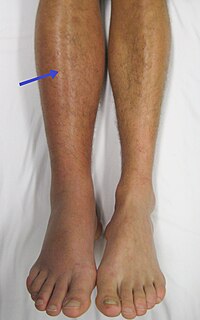
Photo from wikipedia
The authors retrospectively reviewed a nationwide surveillance to identify risk factors contributing to complications and short-term clinical outcomes in the endovascular treatment of brain arteriovenous malformations. A total of 1042… Click to show full abstract
The authors retrospectively reviewed a nationwide surveillance to identify risk factors contributing to complications and short-term clinical outcomes in the endovascular treatment of brain arteriovenous malformations. A total of 1042 endovascular procedures (788 patients) performed in 111 institutions from 2010 to 2014 were reviewed. Univariate analysis identified deep venous drainage, associated aneurysms, infratentorial location, and pre-radiosurgical embolization as statistically significant risk factors for complications. Multivariate analysis showed that embolization of brain arteriovenous malformations in the infratentorial location was significantly associated with complications. BACKGROUND AND PURPOSE: Embolization is widely performed to treat brain arteriovenous malformations, but little has been reported on factors contributing to complications. We retrospectively reviewed a nationwide surveillance to identify risk factors contributing to complications and short-term clinical outcomes in the endovascular treatment of brain arteriovenous malformations. MATERIALS AND METHODS: Data for endovascular treatment of brain arteriovenous malformations were extracted from the Japanese nationwide surveillance. Patient characteristics, brain arteriovenous malformation features, procedures, angiographic results, complications, and clinical outcomes at 30 days postprocedure were analyzed. RESULTS: A total of 1042 endovascular procedures (788 patients; mean, 1.43 ± 0.85 procedures per patient) performed in 111 institutions from 2010 to 2014 were reviewed. Liquid materials were used in 976 procedures (93.7%): to perform presurgical embolization in 638 procedures (61.2%), preradiosurgical embolization in 160 (15.4%), and as sole endovascular treatment in 231 (22.2%). Complete or near-complete obliteration of brain arteriovenous malformations was obtained in 386 procedures (37.0%). Procedure-related complications occurred in 136 procedures (13.1%), including hemorrhagic complications in 59 (5.7%) and ischemic complications in 57 (5.5%). Univariate analysis identified deep venous drainage, associated aneurysms, infratentorial location, and preradiosurgical embolization as statistically significant risk factors for complications. Multivariate analysis showed that embolization of brain arteriovenous malformations in the infratentorial location was significantly associated with complications. Patients with complications due to endovascular procedures had worse clinical outcomes 30 days after the procedures than those without complications. CONCLUSIONS: Complications arising after endovascular treatment of brain arteriovenous malformations are not negligible even though they may play a role in adjunctive therapy, especially in the management of infratentorial brain arteriovenous malformations.
Journal Title: American Journal of Neuroradiology
Year Published: 2020
Link to full text (if available)
Share on Social Media: Sign Up to like & get
recommendations!